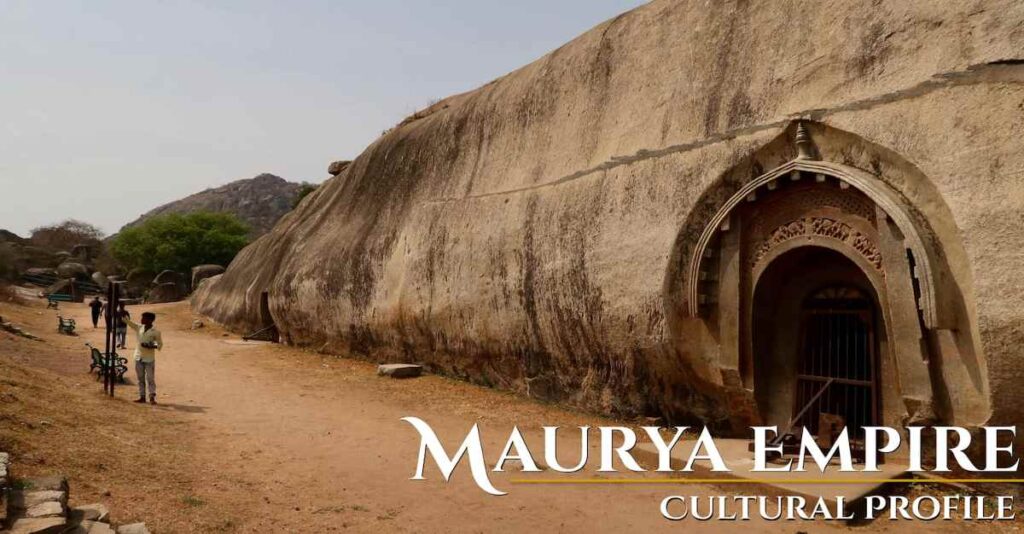The Arts of the Mauryan Period in Indian Culture
Between the fourth and second century B.c.Mauryan craftsmanship flourished(Mauryan Period). Mauryan Empire was the principal realm to control a large part of the Indian subcontinent. It signified a huge change in Indian workmanship from the utilization of wood to stone. Mauryan monarchs, particularly Ashoka, were known for their royal craftsmanship.
In the fourth century BCE, the Mauryas had set up a strong groundwork for themselves as a solid power, and by the third hundred years, they had huge areas of India under their situation. Various severe rituals existed throughout this period, including the worship of Yakshas and goddesses. Regardless of this, Buddhism has turned into the most well-known religion.
Giant stone figures and building improvements occurred just during the Mauryan time frame, after the Harappan civilization. Points of support, figures, rock-cut designs, and designs like stupas, viharas, and chaityas filled an assortment of needs. They are sublime with regards to stylish quality as well as planning and execution.


Pillars and Sculptures
The most popular and most noteworthy works of Ashoka are the imaginatively cut creature capitals that make their due from a couple of his support points, particularly the Lion Capital of Sarnath, which is as of now India’s National Emblem.
The support points and capitals reflect court craftsmanship, and various more modest earthenware works address enduring well-known workmanship(Mauryan Period).
Terracotta utilized arts
The well-known terracotta bits of all sizes are found at Mauryan destinations and abroad and are the most plentiful. They are more plentiful in Pataliputra and Taxila. Many have adapted to shapes and are more capable. God puppets, votive reliefs with divinities, toys, dice, embellishments, and dabs are among the earthenware from Taxila.
Terracotta images of traditional gods are widespread, and they also include a few dolls. Plenty of animal figurines are presumably toys for youngsters.
Paintings by Maurya
Megasthenes claims that the Mauryans had some excellent paintings, but no examples have survived. The paintings of Ajanta, the primary critical assortment of Indian workmanship, mirror a very much better culture that existed for quite a while during the Mauryan times.
Pottery works
The Mauryan time frame is related to a few unmistakable kinds of earthenware. Nonetheless, the most refined strategy might be found in Northern Black Polished Ware (NBPW), a sort of pottery that was normal all through the former and early Mauryan times.
It includes a profoundly cleaned coat covering that reaches in variety from dark black to profoundly dim or metallic steel blue.
Now and again, there are minimal red-earthy colored regions apparent on a superficial level. It has an extraordinary sheen and brilliance that separates it from other cleaned or graphite-covered red items.
Architecture works
Construction remained the preferred material with the second shift to the use of block and stone. In the Arthashastra, Kautilya suggests the utilization of blocks and stone gave their perseverance. In any case, he dedicates a significant segment to precautionary measures to be taken against flames in lumber structures, exhibiting their notoriety.
According to the Greek agent Megasthenes, Pataliputra’s city was encircled by a massive wooden wall with gaps or cuts through which bowmen could shoot. One of the designs, an 80-pillared lobby at Kumrahar, is particularly important. A few stupas, notably those at Sanchi, Sarnath, and presumably Amaravati, were built as block and stonework mountains during Ashoka’s reign.
Various coins – Mauryan Period
They stamped silver and a couple of copper coins in an assortment of shapes, sizes, and loads, each with at least one image punched on them. The most renowned symbols are the elephants and the mountain. The metal was cut first, and afterward, the gadget was punched, which was the standard technique for making such coins.
Conclusion
Mauryan art and architecture play a significant part in the authenticity of Ancient India. Since the domain stretched out to an immense region(Mauryan Period), the art of this period realm voyaged significant distances and gained significant appreciation.
